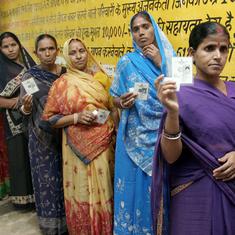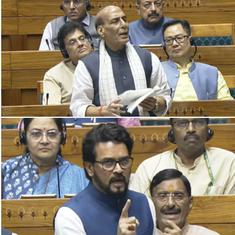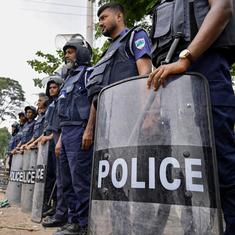Kurubarahalli is a congested corner of India’s technology capital, packed with narrow roads, alleys, heavy traffic, shops and darshinis, as small self-service eateries are called here. The area starts humming with activity as early as 7.30 am.
Among the first to arrive at the labour hub here are daily wagers seeking employment. On any working day you can see 1,000-1,500 workers waiting to be picked up for jobs, mostly as plumbers, painters, carpenters and masons. Women search for jobs as helpers, mixing concrete or moving bricks.
Labour contractors arrive here on motorcycles or auto-rickshaws to pick up the day’s supply of workers, most of whom they know by face. The official minimum wage for a skilled worker is Rs 600 a day for men and Rs 300 for women. By noon, those who can will have found a job, and by 2 pm the labour hub will have emptied out.
Among those waiting at Kurubarahalli for cleaning and plastering jobs was Swamy, 36. He migrated to Bengaluru five years ago from Pandavapura in Mandya district, 130 km southwest of the capital city. An illiterate man, he wanted to earn enough to provide a good “convent” education for his three daughters, one of whom is physically challenged and in need of constant care.
Swamy must now be satisfied with two to three days of work a week. “Even that is a blessing,” he said.

In November 2016, the Modi government decided to withdraw 86% of India’s currency, by value, knocking the bottom out of the casual jobs sector which ran on cash payments, as IndiaSpend reported in this 2017 series. Till then, Swamy and his wife, a domestic worker, were together earning about Rs 25,000 a month. Today, they struggle to collectively make between Rs 10,000-Rs 15,000 per month. The 20 days of work a month that Swamy was once assured of have dwindled to 10.
About five million men, mostly from the unorganised sector, lost their jobs over the two years following demonetisation, said an April 2019 report, the latest estimate of job losses, published by the Centre for Sustainable Employment, Azim Premji University, Bengaluru. The numbers would spiralled if women were to be included.
In 2016, urban Karnataka hosted around 300,000-400,000 workers in the construction sector, said D Rajashekhar, professor of economics at the Institute of Social and Economic Change. Bengaluru’s construction sector hosted a “conservative” 500,000 construction workers, including those from neighbouring areas like Hosur, Dharmapuri, Bidar and Gulbarga, Tumkur, Ramnagar, Kolar among others, said a 2016 study carried out by Venkataramanappa, assistant professor at Bangalore University. Metro rail construction in the city has also pulled in daily wage labourers from neighbouring states of Andhra Pradesh, Telangana and Tamil Nadu.
All these workers were hit when demonetisation was announced.
This is the seventh of IndiaSpend’s 11-part series, reported from nationwide labour hubs – places where unskilled and semi-skilled workers gather to seek contract jobs – to track employment in India’s informal sector. This sector, which absorbs the country’s mass of illiterate, semi-educated and qualified-but-jobless people, employs 92% of India’s workforce, according to a 2016 International Labour Organisation study that used government data.
By delving into the lives and hopes of informal workers, this series provides a reported perspective to ongoing national controversies over job losses after demonetisation and the rollout of the Goods and Services Tax in 2017. The number of jobs declined by a third over four years to 2018, according to a survey by the All India Manufacturers’ Organisation, which polled 34,700 of its 300,000 member-units.
In 2018 alone, 11 million jobs were lost, mostly in the unorganised rural sector, according to data from the Centre for Monitoring Indian Economy, a consultancy.
74% of Karnataka’s labour force in informal sector
The Bharatiya Janata Party, in its 2018 assembly election manifesto, promised job creation for young people in Karnataka, though it has one of the lowest unemployment rates in the country. The Congress promised the creation of 1.5 million-2 million jobs per year for the youth in its manifesto. Janata Dal (S), the other big political player in the state, promised jobs for 1 million families.
The Congress and JD(S) alliance, under a “Compete with China” scheme announced in July 2018, aims to create 900,000 manufacturing jobs in four years.
The informal sector in the state employs about 74.01% of the state’s workforce, as per a 2016 report of the Karnataka government’s department of skill development, entrepreneurship and livelihood. Of these workers, only 7% had received skill training as of 2011-12. Amongst the youth (aged 16-35), only 9.4% received skill training.
Construction – along with agriculture and industries – is one of the top three employers of skilled workers in the state: Almost 7% of the total workforce is engaged in construction work, and 55.7% in agriculture.
Appanna (he uses one name), Karnataka general secretary of the All India Central Council Trade Union, estimated that Bengaluru itself currently hosts about 800,000 to 1 million construction labourers.
Government schemes in place, but not reaching targeted groups
There is no shortage of institutions and public schemes designed to teach and scale up skills among workers and protect their interests. Karnataka has about 1,507 public and private industrial training institutes and 289 polytechnic institutes, according to this 2013 study by the National Skill Development Corporation. But their enrolment capacity is just at 68.9%. Rural Bengaluru has 16 ITIs and one polytechnic institute, while urban Bengaluru – that has one of Asia’s largest industrial clusters with more than 5,000 medium and small scale enterprises – has 60 polytechnics and 83 ITIs.
The state had set up a Skill Development, Entrepreneurship and Livelihood Department in May 2017. It launched the Chief Minister’s Kaushalya Karnatak Yojane (skill project) to train 500,000 youth every year, particularly school dropouts with the ability to work in MSMEs.
In September 2014, the Deen Dayal Upadhyaya Grameen Kaushalya Yojana had been launched to train 988,014 rural youth in various industrial skills; of them, 695,283 have been trained but only half – 324,956 – of them have been certified.
The Building and Other Construction Workers Act was implemented in Karnataka in 2006 for the welfare of construction labourers in the unorganised sector. Workers registered with the Building and Other Construction Workers board are eligible for educational grants for their children, toolboxes, home building subsidies, medical assistance and insurance and pension, among others. Membership costs workers an initial deposit of Rs 25 and monthly fee of Rs 10. The exact number of labourers who have registered/benefitted from this scheme could not be ascertained.
But these measures appear to have limited reach: Less than 20% of the entire worker population receives welfare benefits and skill training, said Appanna. Swamy told us he knew nothing of these schemes. “Who can be bothered with enrolling in these schemes?” he said.
At the Kurubarahalli labour hub, most workers echoed support for the Congress, believing that the job situation would improve if the party is voted to power in the ongoing 2019 general elections. A few like daily wager Manjunath told us that they were “deeply unhappy” with demonetisation and GST but were satisfied with the manner in which the Indian government dealt with the threat to India’s security from across the border.
‘Finding a job is a nightmare’
Karnataka’s construction sector contributes around 9% of the state’s gross domestic product, as a 2013 report by the National Skill Development Corporation estimated, and is a big employer of youth. However, demonetisation deflated the real estate sector, impacting the construction sector as we said earlier.
In the years preceding demonetisation, most workers told us, they would get jobs quite easily. “Now it is a nightmare,” said a worker who did not wish to be named. “Demonetisation posed a serious threat to our livelihood. But the demand for skilled labour is high.”
Umesh (he gave us only one name), 52, is among the construction daily wagers whose earnings fell by 33% after demonetisation. He earns between Rs 5,000 to Rs 8,000 per month, finding work only three to four days a week. He has an “eye problem” that is yet to be diagnosed and does not allow him to handle certain construction jobs. Before demonetisation, he earned Rs 600 or more for a day’s work; this is now down to Rs 400. His wife works as a domestic helper and earns Rs 1,500-Rs 2,000 per house. Together the family earns about Rs 20,000 a month.
The impact of demonetisation, further compounded by GST, is also being felt by employers. Nizar (he gave us only one name), 46, works as a supervisor at a brick factory. His company faced a “huge drop” in sales following the implementation of GST. Even a senior employee like him has not been given a raise since 2016. Three of the eight workers under him left in search of higher wages.
Ranganath Kalappagowda, a 48-year-old mechanical engineer, owns a small construction company in Devanahalli on the outskirts of Bengaluru. In the wake of demonetisation, he did not have the cash to pay his daily wage workers–both skilled and unskilled–and he had to cut down his workforce from 20 to 14 labourers. He now pays his workers nearly half of what he did earlier–no more than Rs 10,000 a month. The amount is lower for unskilled workers.
Women workers bear the brunt
Women workers are dealing with many more problems. The employment squeeze felt after demonetisation hit women hardest. “A fall in employment is usually concentrated among women. We saw this in the aftermath of demonetisation. The entire brunt of that fall was borne by women,” said the Centre for Monitoring Indian Economy, which estimated that of the 11 million jobs lost, women lost 8.8 million or 80%.
Nagamma, a labourer in her late 30s, stood looking hurried at Kurubarahalli. Her bright yellow saree, pink blouse and green bangles couldn’t hide the exhaustion on her face and the worry lines etched on them. She is among the millions of women workers dealing with a drastic fall in job opportunities in the informal sector.

Before demonetisation, Nagamma could find work 20 days a month; this is down to 10 now. She earns about Rs 300 a day as a helper at construction sites and manages to collect about Rs 3,000-Rs 4,000 a month. Her husband earns under Rs 10,000 a month by working around 10-12 days. The loss of earning opportunities sent him into depression and soon after he took to drinking, a habit that sucks out a large part of his earnings.
Stories like these are common to many women at the hub. Thirty-year-old Shivagangamma’s day starts at 5 am–she works as a domestic help in multiple homes around Kamala Nagar in Kurubarahalli. These jobs earn her around Rs 4,000 a month. She wraps up these chores by 8 am and then heads for the labour hub at Kurubarahalli in search of a job as a helper–lifting bricks, filling potholes and so on. These jobs fetch her around Rs 300 a day.
Not only did demonetisation impact the family’s monthly income and savings, but it also pushed her husband, who handles plumbing and carpentry jobs, towards alcohol. She has no option but take on multiple jobs in a day to pay the rent for their one bedroom flat in Kamala Nagar, about 2 km from Kurubarahalli.

The working conditions for daily wagers is “pathetic”, said Rajashekhar, who has studied the condition of unorganised in Karnataka. Not only do they not have access to basic facilities like drinking water or toilets, but female labourers have an added burden of facing emotional and sexual abuse as well, he said.
A woman worker we spoke to, who did not wish to be named, said she had been harassed at work but suffered in silence because she was the sole provider for her family.
This is the seventh of 11 reports. The previous stories from: Indore, Jaipur, Perumbavoor, Ahmedabad, Kolkata and Lucknow.
This article first appeared on IndiaSpend, a data-driven and public-interest journalism non-profit.










